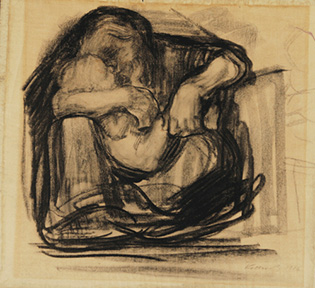- Home
- Products
KATHE KOLLWITZ

Käthe Kollwitz
Käthe Kollwitz (July 8, 1867 – April 22, 1945) was a German painter, printmaker, and sculptor whose work offered an eloquent and often searing account of the human condition, and the tragedy of war, in the first half of the 20th century. Her empathy for the less fortunate, expressed most famously through the graphic means of drawing, etching, lithography, and woodcut, embraced the victims of poverty, hunger, and war.
Kollwitz was born as Käthe Schmidt in Königsberg (now Kaliningrad, Russia), East Prussia, the fifth child in her family. Her father, Karl Schmidt, was a radical Social democrat who became a mason and house builder. Her mother, Katherina Schmidt, was the daughter of Julius Rupp, a Lutheran pastor who was expelled from the official Evangelical State Church in Prussia and founded an independent congregation. Her education was greatly influenced by her grandfather's lessons in religion and socialism.
At sixteen she began making drawings of working people, the sailors and peasants she saw in her father's offices. Wishing to continue her studies at a time when no colleges or academies were open to young women, Kollwitz enrolled in an art school for women in Berlin. There she studied with Karl Stauffer-Bern, a friend of the artist Max Klinger. The etchings of Klinger, their technique and social concerns, were an inspiration to Kollwitz.
At the age of seventeen, Kollwitz became engaged to Karl Kollwitz, a medical student. In 1888, she went to Munich to study at the Women's Art School, where she realized her strength was not as a painter, but a draughtsman. In 1890, she returned to Königsberg, rented her first studio, and continued to draw labourers.
In 1891, Kollwitz married Karl, by this time a doctor, who tended to the poor in Berlin, where the couple moved into the large apartment that would be Kollwitz' home until it was destroyed in World War II. The proximity of her husband's practice proved invaluable.
Käthe Kollwitz is a subject within William T. Vollmann's Europe Central, a 2005 National Book Award winner for fiction. In the book, Vollmann describes the lives of those touched by the fighting and events surrounding World War II in Germany and the Soviet Union. Her chapter is entitled "Woman with Dead Child", after her sculpture of the same name.
An enlarged version of a similar Kollwitz sculpture, Mother with her Dead Son, was placed in 1993 at the center of Neue Wache in Berlin, which serves as a monument to "the Victims of War and Tyranny".
Artist Birgit Stauch depicted Kollwitz in a bronze bust displayed in the Käthe-Kollwitz-Schule in Esslingen, one of more than 40 German schools named after her.
Show More
